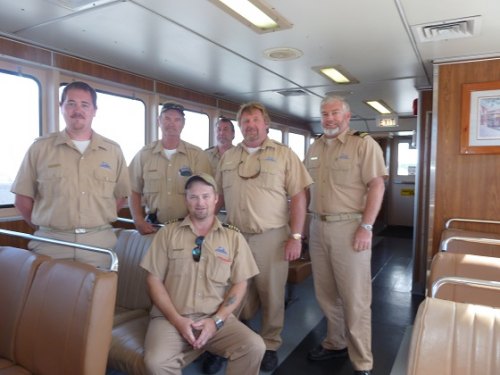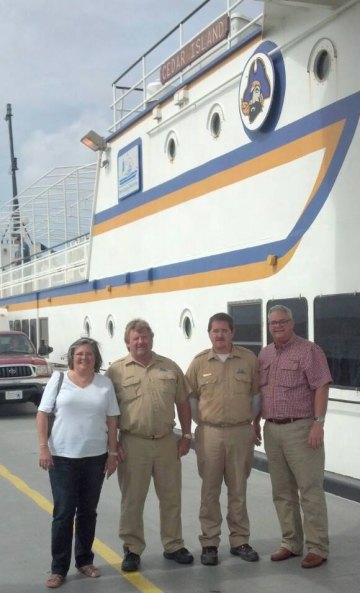Ferry Crew Rescues Sailors
Crew members on the 8 pm Cedar Island ferry made a daring rescue in 30 knot winds and 4 - 5 foot seas that likely saved the lives of John and Renee Hoffman. The Hoffman's have sailed their 31' sloop, Exit Strategy, into Ocracoke at night before, and left Washington, NC under promising conditions earlier that afternoon.

Steady winds created steep chop in the shallow waters of Pamlico Sound. The heavy seas may have damaged Exit Strategy's rudder, leaving the husband and wife team of captain and crew at the mercy of the wind and waves.
Captain Dennis Mullen of Different Drummer was snug on the docks in Silver Lake, idly monitoring channel 16 when he heard the distress call from Exit Strategy. Captain Hoffman told the Coast Guard they were aground at a 40 degree angle and taking on water, in fear of capsizing, said Mullen.
Then radio communication from the distressed vessel went silent. It was eerie, said Mullen.
“It happened so fast. The boat flipped and we were thrown into the water,” said John Hoffman in this press release from NC DOT.
Cedar Island Ferry Captain Steven Goodwin was monitoring the situation as well. The ferry was leaving Ocracoke on its last run of the day, piloting through the same channel the Hoffmans were now powlerless to navigate.
"I heard them call the Coast Guard and say they'd lost their rudder," said Goodwin. "I watched them go aground and called the Coast Guard as we went by them. When I turned around and looked, the boat had capsized. I told the Coast Guard we would try to make an attempt at rescue."
Goodwin had to pass the foundering vessel in order to turn the ferry around in a wider part of the channel.
Passenger Lou Proctor was wrapping up a day of celebrating her birthday on Ocracoke. She wondered why the ferry was slowing down after being underway for only 15 or 20 minutes. There was a blast over the intercom and she heard the phrase "assist vessel in distress."
"We jumped out of the car and I swear I saw a boat floating by on its side," said Proctor.

During the time it took Goodwin to turn the ferry around, Exit Strategy had sunk, and drifted into the narrow channel.
The lights were still on, even though the boat was underwater, said crew member Randy Willis.
Captain Goodwin had to squeeze the ferry between the sunken sailboat and a channel marking nun. He had "about 6 foot to play with" without putting his own vessel and passengers in jeopardy. Avoiding entangling his propellers in the underwater sailboats gear was paramount.
Although he wasn't confident the 16' tender of the m/v Cedar Island could be safely launched in heavy seas, Captain Goodwin went ahead and made the call, being that help from the Coast Guard would have to come by boat from Hatteras, or from a military chopper out of Cherry Point.
In the mid 70 degree water, the Hoffmans drifted about 100 yards from their boat into the calmer water behind the island formed by dredge spoils. If the Cedar Island hadn't been conveniently nearby when their boat capsized, the Hoffmans could probably have survived a few hours before hypothermia set in. Finding them in the dark, high seas would have challenged rescuers as they continued to drift. Both were wearing PFD's with reflective tape.
The lifeboat with crew Glenn Salter and Daniel Smith was launched on the leeward side.
"They went out there. It was unbelievable," said Proctor. "All of a sudden they're coming back with two other people on board."
Ms. Hoffman told Salter to rescue her husband first, as he is a heart and lung patient. The sailors were in the dark water for over 20 minutes, and chilled to the bone when they were brought aboard the Cedar Island.
"Everybody had a lot of adrenaline at this point, including us," said Proctor, who was impressed by the composure of the crew and the Hoffmans. "Those guys were out there in really high seas, holding on to each other."
"The ferry people deserve a lot of credit," said Proctor. "They did a great job, and the story has a happy ending."
Though the rescue probably only took 10 or 15 minutes, it seemed longer, said Captain Goodwin, a 22 year veteran of the ferry who has been a Captain since 1999. "I had a radio in both hands. I was trying to keep the boat in the center of the channel, with the sea and the tide setting to. We train every week for this stuff. In a real life situation, the training takes over. I done stuff I don't remember doing."
The seven crew members of the Cedar Island who were involved in the rescue are modest about their heroism. "It is just our job. We do the drill, do the job," said Salter.
"Everybody had a job to do and did it well," said Willis.
The ferry returned to the nearest port--Ocracoke--where the Port Captain gave the Hoffman's dry clothes, and the Anchorage Inn offered them a warm, dry room for the night.





